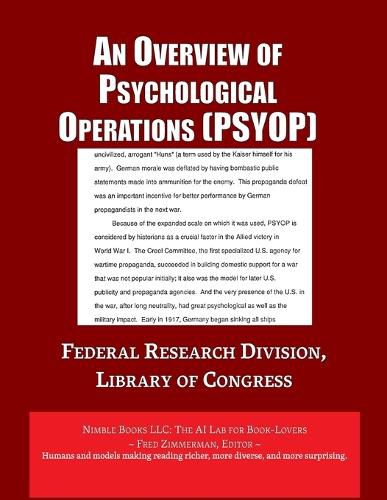Readings Newsletter
Become a Readings Member to make your shopping experience even easier.
Sign in or sign up for free!
You’re not far away from qualifying for FREE standard shipping within Australia
You’ve qualified for FREE standard shipping within Australia
The cart is loading…






A professional snapshot of the state of the federal government's knowledge of psychological warfare at the end of the Cold War.
This document written by the Federal Research Division of the Library of Congress for an unnamed federal agency provides a comprehensive overview of psychological operations (PSYOP) with a specific focus on military applications in the context of the Cold War era (up to November 1989).
Key Points:
-Definition of PSYOP: The document clarifies the evolving definition of PSYOP, from influencing enemy attitudes in wartime to a broader scope encompassing peacetime activities aimed at shaping emotions, attitudes, and behaviors of foreign groups to achieve political and military objectives.
-Historical Context: The paper explores historical examples of PSYOP, highlighting instances like Judith and Holofernes, Ghengis Khan, and the American Revolution, showcasing the enduring value of psychological tactics in warfare.
-Soviet PSYOP: The document delves into the Soviet Union's extensive and sophisticated PSYOP machinery, emphasizing their philosophy of constant ideological warfare against the capitalist world. It details the roles of various Soviet agencies like the International Department, Propaganda Department, and the KGB in conducting active measures and disinformation campaigns.
-United States PSYOP: The paper examines the US approach to PSYOP, characterized by a historical reluctance towards peacetime PSYOP and a reactive posture. It discusses the challenges faced by the US in countering Soviet propaganda and the need for improved coordination and resources.
-Evolving Landscape: The document acknowledges the changing nature of warfare, with the rise of unconventional conflicts and low-intensity conflicts, necessitating a greater emphasis on PSYOP.
Strengths of the Document:
-Comprehensive Overview: The paper provides a well-structured and informative analysis of PSYOP, covering historical examples, theoretical frameworks, and contemporary applications.
-Comparative Approach: The document effectively compares and contrasts the Soviet and US approaches to PSYOP, highlighting their strengths and weaknesses.
-Emphasis on Contemporary Challenges: The paper acknowledges the changing nature of warfare and the increasing importance of PSYOP in the context of unconventional and low-intensity conflicts.
Potential Limitations:
-Dated Information: As the document predates November 1989, it does not consider the significant geopolitical shifts that occurred after the Cold War, such as the collapse of the Soviet Union and the rise of new threats and challenges.
-Focus on Military Applications: While the document acknowledges the broader scope of PSYOP, its primary focus remains on military applications, potentially overlooking the growing importance of PSYOP in non-military domains like diplomacy, business, and social movements.
Overall, this document offers valuable insights into the theory and practice of PSYOP during the Cold War era. However, it is crucial to consider the limitations of its dated information and recognize the evolving nature of PSYOP in the contemporary world.
$9.00 standard shipping within Australia
FREE standard shipping within Australia for orders over $100.00
Express & International shipping calculated at checkout
A professional snapshot of the state of the federal government's knowledge of psychological warfare at the end of the Cold War.
This document written by the Federal Research Division of the Library of Congress for an unnamed federal agency provides a comprehensive overview of psychological operations (PSYOP) with a specific focus on military applications in the context of the Cold War era (up to November 1989).
Key Points:
-Definition of PSYOP: The document clarifies the evolving definition of PSYOP, from influencing enemy attitudes in wartime to a broader scope encompassing peacetime activities aimed at shaping emotions, attitudes, and behaviors of foreign groups to achieve political and military objectives.
-Historical Context: The paper explores historical examples of PSYOP, highlighting instances like Judith and Holofernes, Ghengis Khan, and the American Revolution, showcasing the enduring value of psychological tactics in warfare.
-Soviet PSYOP: The document delves into the Soviet Union's extensive and sophisticated PSYOP machinery, emphasizing their philosophy of constant ideological warfare against the capitalist world. It details the roles of various Soviet agencies like the International Department, Propaganda Department, and the KGB in conducting active measures and disinformation campaigns.
-United States PSYOP: The paper examines the US approach to PSYOP, characterized by a historical reluctance towards peacetime PSYOP and a reactive posture. It discusses the challenges faced by the US in countering Soviet propaganda and the need for improved coordination and resources.
-Evolving Landscape: The document acknowledges the changing nature of warfare, with the rise of unconventional conflicts and low-intensity conflicts, necessitating a greater emphasis on PSYOP.
Strengths of the Document:
-Comprehensive Overview: The paper provides a well-structured and informative analysis of PSYOP, covering historical examples, theoretical frameworks, and contemporary applications.
-Comparative Approach: The document effectively compares and contrasts the Soviet and US approaches to PSYOP, highlighting their strengths and weaknesses.
-Emphasis on Contemporary Challenges: The paper acknowledges the changing nature of warfare and the increasing importance of PSYOP in the context of unconventional and low-intensity conflicts.
Potential Limitations:
-Dated Information: As the document predates November 1989, it does not consider the significant geopolitical shifts that occurred after the Cold War, such as the collapse of the Soviet Union and the rise of new threats and challenges.
-Focus on Military Applications: While the document acknowledges the broader scope of PSYOP, its primary focus remains on military applications, potentially overlooking the growing importance of PSYOP in non-military domains like diplomacy, business, and social movements.
Overall, this document offers valuable insights into the theory and practice of PSYOP during the Cold War era. However, it is crucial to consider the limitations of its dated information and recognize the evolving nature of PSYOP in the contemporary world.